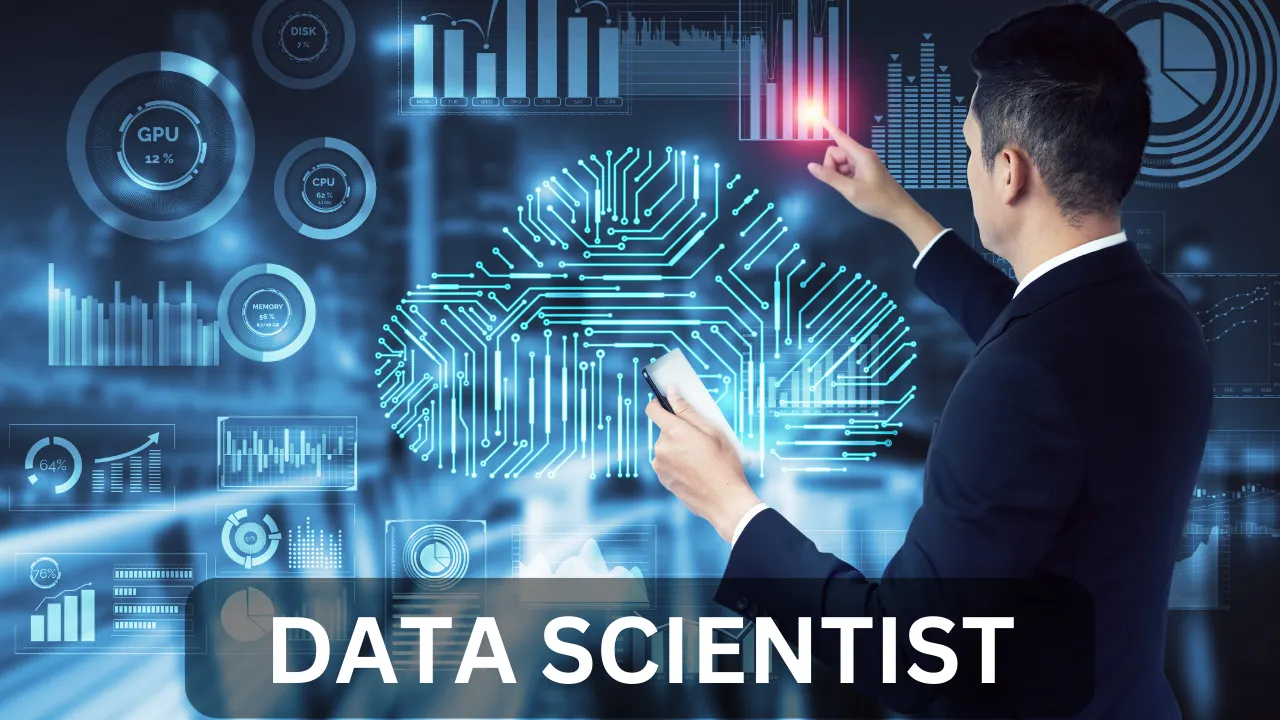
Executive Summary
In today’s data-driven world, data scientists are among the most in-demand professionals across industries. Organizations rely on them to analyze complex datasets, uncover patterns, make predictions, and drive strategic decisions. The role is dynamic, combining mathematics, statistics, programming, business insight, and communication skills.
This guide provides a step-by-step roadmap to becoming a data scientist, covering the education, skills, tools, practical experience, certifications, career opportunities, and growth strategies required to thrive in this exciting field. Whether you are a student, professional, or career switcher, this guide will equip you with everything needed to launch and advance a career in data science.
Table of Content
1. Understanding the Role of a Data Scientist
1.1 Definition and Purpose
A data scientist is a professional who collects, analyzes, and interprets large and complex datasets to help organizations make informed decisions. The role is often described as a combination of statistician, computer scientist, and business analyst.
Key purposes include:
- Extracting meaningful insights from structured and unstructured data.
- Building predictive models to forecast trends and outcomes.
- Supporting data-driven decision-making for business growth and operational efficiency.
- Identifying opportunities, inefficiencies, and risks through data analysis.
1.2 Why Data Scientists Are Important
The exponential growth of data from sources like social media, IoT devices, e-commerce platforms, and enterprise systems has created a huge demand for skilled professionals who can interpret this information. Data scientists help organizations:
- Reduce operational costs by identifying inefficiencies.
- Improve marketing and customer engagement by analyzing behavior patterns.
- Enhance product development through data-driven insights.
- Minimize risks by predicting potential challenges or failures.
1.3 Core Responsibilities
The responsibilities of a data scientist typically include:
- Data Collection and Cleaning – Acquiring data from multiple sources and preparing it for analysis.
- Data Analysis and Modeling – Applying statistical and machine learning techniques to identify patterns.
- Data Visualization and Communication – Presenting findings using charts, dashboards, or reports for decision-makers.
- Problem Solving and Decision Support – Translating business problems into data-driven solutions.
- Collaboration with Teams – Working closely with engineers, analysts, and managers to implement strategies.
2. Educational Pathways
2.1 Undergraduate Degrees
A strong foundation in quantitative and technical fields is critical. Relevant degrees include:
- Computer Science – Focus on programming, algorithms, and software engineering.
- Mathematics or Statistics – Emphasis on probability, statistical modeling, and analysis.
- Engineering – Exposure to analytical problem-solving and technical modeling.
- Economics or Business Analytics – Understanding data in a business context.
Key courses to focus on:
- Calculus, Linear Algebra, Probability, and Statistics
- Data Structures and Algorithms
- Database Management Systems
- Programming languages (Python, R, SQL)
2.2 Advanced Degrees
While a master’s degree or PhD is not always required, advanced degrees provide:
- Deeper analytical and technical knowledge
- Opportunities to specialize in machine learning, AI, or big data
- Higher earning potential and leadership roles in analytics or research
Recommended programs:
- Master’s in Data Science
- Master’s in Artificial Intelligence or Machine Learning
- PhD in Statistics, Computer Science, or Data Analytics
2.3 Online Courses and Certifications
For career switchers or professionals, online certifications offer flexible learning paths:
- Coursera: Data Science Specialization by Johns Hopkins University, IBM Data Science Professional Certificate
- Udemy: Complete Data Science Bootcamp
- EdX: MicroMasters in Data Science
- DataCamp: Python, R, SQL, Machine Learning tracks
Certifications demonstrate commitment to learning and provide practical skills for entry-level roles.
Enhance Your Data Scientist Journey
Ready to step into the world of data science with real-skills that matter? Explore these three courses:
- Generative AI for Data Scientists Specialization — Learn how to apply cutting-edge AI tools in data science workflows.
- The Data Scientist’s Toolbox — Build a strong foundation with the essential tools every data scientist uses.
- AI Fundamentals for Non-Data Scientists — If you’re coming from a non-technical background, this one helps you bridge the gap and gain confidence in AI and data science.
3. Technical Skills Required
Data science is highly technical. Key skills include:

3.1 Programming
- Python: Widely used for data analysis, machine learning, and scripting.
- R: Preferred for statistical analysis and visualizations.
- SQL: Essential for querying structured databases.
- Optional: Java, Scala for big data processing.
3.2 Statistics and Mathematics
- Probability and Statistical Analysis
- Regression, Classification, and Clustering
- Linear Algebra and Calculus for algorithm understanding
3.3 Machine Learning & AI
- Supervised and Unsupervised Learning
- Predictive and Prescriptive Modeling
- Deep Learning for NLP and Computer Vision
3.4 Data Manipulation and Analysis
- Using Pandas, NumPy, or dplyr to process large datasets
- Handling missing values, normalization, and data cleaning
3.5 Data Visualization
- Presenting insights clearly using Tableau, Power BI, Matplotlib, Seaborn
- Communicating complex results to non-technical stakeholders
3.6 Big Data Tools
- Hadoop, Spark, and cloud platforms (AWS, Azure, GCP) for processing large-scale data
- Familiarity with distributed systems and data pipelines
3.7 Soft Skills
- Critical thinking and problem-solving
- Communication and storytelling with data
- Collaboration across teams and departments
4. Gaining Practical Experience
Practical exposure is essential to bridge the gap between theory and real-world application.
4.1 Projects
- Build predictive models (e.g., sales forecasting, churn prediction)
- Analyze publicly available datasets (e.g., Kaggle, UCI Machine Learning Repository)
- Create dashboards and visualizations for storytelling
4.2 Internships
- Real-world experience in tech companies, startups, or research labs
- Exposure to business problems, enterprise datasets, and cross-functional teams
4.3 Competitions and Hackathons
- Participate in Kaggle competitions to solve real-world problems
- Collaborate with peers in hackathons to apply machine learning, analytics, and visualization skills
4.4 Portfolio Development
- Showcase projects, code, and reports on GitHub or personal websites
- Include a clear problem statement, methodology, results, and visualizations
5. Networking and Professional Development
5.1 Building a Network
- Join professional communities and forums: Kaggle, Reddit, LinkedIn groups
- Attend webinars, conferences, and workshops
- Connect with mentors and industry experts
5.2 Online Presence
- Maintain a strong LinkedIn profile highlighting skills, certifications, and projects
- Share insights, write articles, and contribute to discussions in data science communities
5.3 Mentorship
- Seek guidance from experienced data scientists
- Participate in mentorship programs to receive feedback on skills and career decisions
6. Job Search and Entry-Level Roles

6.1 Entry-Level Roles
- Data Analyst → Data Scientist
- Junior Data Scientist
- Machine Learning Engineer (technical focus)
- Business Intelligence Analyst
6.2 Resume Tips
- Highlight technical skills (Python, R, SQL, Tableau)
- Showcase practical projects and portfolios
- Include certifications, internships, and competitions
6.3 Interview Preparation
- Review core concepts: statistics, probability, algorithms
- Practice coding and SQL queries
- Prepare to discuss projects, methodologies, and outcomes
Data science careers often overlap with advanced education and specialized technical roles.
- To understand the academic side of research and analysis, explore What Does PhD Stand For? — it explains how doctoral study can support data-driven innovation.
- For those who want to explore the engineering foundation of data systems, What Does a Data Engineer Do? provides a detailed look at how data pipelines and infrastructure power analytics.
- Beginners who are still exploring this path can check How to Start a Career in Data Science, which breaks down the first steps to enter this fast-growing field.
7. Career Growth and Specializations
7.1 Career Path
- Entry-Level: Junior Data Scientist, Data Analyst
- Mid-Level: Data Scientist, Machine Learning Engineer, Data Engineer
- Senior-Level: Senior Data Scientist, AI Specialist, Analytics Manager
- Leadership Roles: Chief Data Officer (CDO), Head of Data Science
7.2 Specialization Areas
- Natural Language Processing (NLP) – Text analysis, chatbots, sentiment analysis
- Computer Vision – Image and video analysis
- Predictive Analytics – Forecasting and decision modeling
- Big Data Engineering – Managing large-scale distributed datasets
7.3 Freelance Opportunities
- Contract-based projects for companies needing analytics or machine learning expertise
- Consulting for startups or enterprises in AI and data analytics
8. Challenges in Becoming a Data Scientist
- Handling large and unstructured datasets
- Keeping up with evolving tools, libraries, and frameworks
- Translating technical findings into business insights
- Navigating data privacy, security, and regulatory compliance
9. Tools and Technologies Overview
| Category | Tools & Platforms |
|---|---|
| Programming | Python, R, SQL, Java, Scala |
| Data Manipulation | Pandas, NumPy, dplyr |
| Machine Learning | scikit-learn, TensorFlow, PyTorch, XGBoost |
| Visualization | Tableau, Power BI, Matplotlib, Seaborn |
| Big Data | Hadoop, Spark, AWS, Azure, GCP |
| Collaboration | Git, Jupyter Notebook, Google Colab |
10. Benefits of a Data Science Career
- High Demand & Job Security – Organizations worldwide require data expertise.
- Competitive Salaries – Entry-level roles start at $70k–$90k; senior roles $150k+.
- Career Flexibility – Work across industries: healthcare, finance, tech, retail, government.
- Intellectual Challenge – Solve complex problems with creativity and analytical skills.
- Remote Work Opportunities – Many roles allow flexible and remote work.
11. Continuous Learning
Data science is evolving rapidly. Staying relevant requires:
- Following industry blogs, research papers, and news
- Taking advanced courses and certifications
- Experimenting with new tools, algorithms, and datasets
- Contributing to open-source projects
12. Sample Roadmap to Become a Data Scientist
Phase 1: Foundations (0–6 months)
- Learn Python, SQL, and basic statistics
- Complete beginner-level projects
- Take online introductory courses
Phase 2: Intermediate Skills (6–12 months)
- Learn machine learning algorithms and data visualization
- Work on Kaggle competitions
- Build a portfolio
Phase 3: Advanced Skills (12–18 months)
- Specialize in AI, NLP, or Big Data
- Complete internships or freelance projects
- Prepare for interviews and certifications
Phase 4: Career Launch (18+ months)
- Apply for entry-level data scientist roles
- Continue skill development and specialization
- Network actively and seek mentorship
13. Conclusion
Becoming a data scientist is a structured yet flexible journey that combines education, technical expertise, hands-on experience, and continuous learning. With the growing reliance on data across industries, a career in data science offers strong growth, competitive salaries, and opportunities to solve real-world problems. By following a step-by-step roadmap—from learning foundational skills, building a portfolio, gaining practical experience, to networking and specialization—aspiring data scientists can build rewarding careers in this exciting field.


